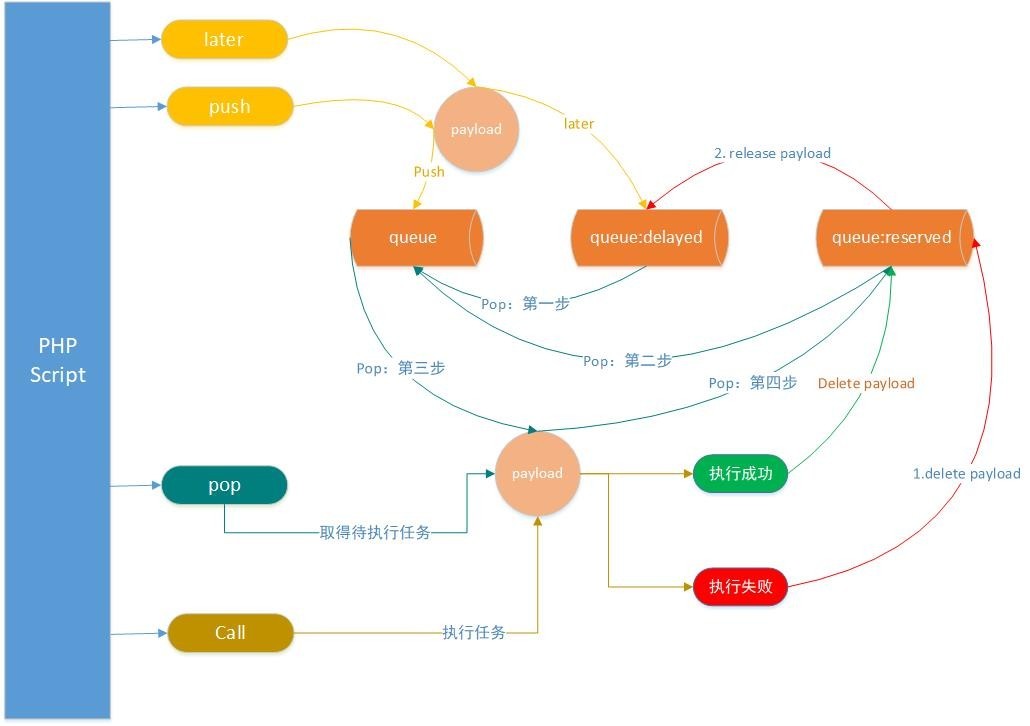Laravel 源码阅读 - Queue
一、 依赖的服务
1.1 QueueServiceProvider
Illuminate\Queue\QueueServiceProvider队列服务由服务提供者QueueServiceProvider注册。
- registerManager() 注册队列管理器,同时添加 Null/Sync/Database/Redis/Beanstalkd/Sqs 连接驱动
- Null:不启动队列,生产者产生的任务被丢弃
- Sync:同步队列,生产者产生的任务直接执行
- Database:数据库队列驱动,生产者产生的任务放入数据库
- Redis:Redis队列驱动,生产者产生的任务放入Redis
- Beanstalkd:略过
- Sqs:略过
- registerConnection() 注册队列连接获取闭包,当需要用到队列驱动连接时,实例化连接
- registerWorker() 注册队列消费者
- registerListener() Listen模式注册队列消费者
- registerFailedJobServices() 注册失败任务服务
| 注册方法 | 对象 | 别名 |
|---|---|---|
| QueueServiceProvider::registerManager() | \Illuminate\Queue\QueueManager::class | queue |
| QueueServiceProvider::registerConnection() | \Illuminate\Queue\Queue::class | queue.connection |
| QueueServiceProvider::registerWorker() | \Illuminate\Queue\Worker::class | queue.worker |
| QueueServiceProvider::registerListener() | \Illuminate\Queue\Listener::class | queue.listener |
| QueueServiceProvider::registerFailedJobServices() | \Illuminate\Queue\Failed\FailedJobProviderInterface::class | queue.failer |
1.2 BusServiceProvider
Illuminate\Bus\BusServiceProvider这个服务提供者注册了Dispatcher这个服务,可以将具体的任务派发到队列。
二、 任务机制
一个可放入队列的任务类:
<?php
use Illuminate\Bus\Queueable;
use Illuminate\Queue\SerializesModels;
use Illuminate\Queue\InteractsWithQueue;
use Illuminate\Contracts\Queue\ShouldQueue;
use Illuminate\Foundation\Bus\Dispatchable;
class Job implements ShouldQueue
{
use Dispatchable, InteractsWithQueue, Queueable, SerializesModels;
}任务在队列中需要经过两个过程:一个是任务入队,就是将要执行的任务,放到队列中去的过程,所有会发生这一过程的业务、对象、调用等等,可以统称为生产者;与之对应的,将任务从队列中取出,并执行的过程,叫做任务出队,所有会发生这一过程的业务、对象、调用等等,可以统称为消费者。
2.1 任务的要素
2.1.1 Dispatchable
Illuminate\Foundation\Bus\Dispatchable这个trait给任务添加了两个静态方法dispatch/withChain,赋予了任务派发的接口。
dispatch
dispatch方法触发任务指派动作。当执行 Job::dispatch()时,会实例化一个Illuminate\Foundation\Bus\PendingDispatch对象PendingDispatch,并且将任务调用类实例化后的对象job当作构造函数的参数:
// Illuminate\Foundation\Bus\Dispatchable::trait
public static function dispatch()
{
// 这里的static转发到实际执行dispath的类 Job::dispatch,也就是Job类
return new PendingDispatch(new static(...func_get_args()));
}PendingDispatch对象接下来可以通过链式调用来指定队列相关信息 onConnection/onQueue/allOnConnection/allOnQueue/delay/chain,然后在析构函数中,做实际的派发动作:
// Illuminate\Foundation\Bus\PendingDispatch::class
public function __destruct()
{
// Illuminate\Contracts\Bus\Dispatcher
// 这个服务由Illuminate\Bus\BusServiceProvider注册
app(Dispatcher::class)->dispatch($this->job);
}PendingDispath这个中间指派者的作用,就是引出这里从容器中解析出来的服务Dispatcher::class,真正的任务指派者Dispatcher。
withChain
withChain用于指定应该按顺序运行的队列列表。它只是一个语法糖,实际上的效果等同于:
// 1. withChain的用法
Job::withChain([
new OptimizePodcast,
new ReleasePodcast
])->dispatch();
// 2. 等同于dispatch的用法
Job::dispatch()->chain([
new OptimizePodcast,
new ReleasePodcast
])2.1.2 Queueable
Illuminate\Bus\Queueable上文提到的PendingDispath,可以指定队列信息的方法,都是转发到任务对应的方法进行调用,Queueable就是实现了这部分的功能。这部分包括以下接口:
| 方法名 | 描述 |
|---|---|
| onConnection | 指定连接名 |
| onQueue | 指定队列名 |
| allOnConnection | 指定工作链的连接名 |
| allOnQueue | 指定工作链的队列名 |
| delay | 设置延迟执行时间 |
| chain | 指定工作链 |
以及最后一个方法dispatchNextJobInChain。上述方法都是在任务执行前调用,设置任务相关参数。dispatchNextJobInChain是在任务执行期间,如果检查到任务定义了工作链,就会派发工作链上面的任务到队列中。
2.1.3 SerializesModels
Illuminate\Queue\SerializesModels这个trait的作用是字符串化任务信息,方便将任务信息保存到数据库或Redis等存储器中,然后在队列的消费端取出任务信息,并据此重新实例化为任务对象,便于执行任务。
2.1.4 InteractsWithQueue
Illuminate\Queue\InteractsWithQueue这个trait赋予了任务与队列进行数据交互的能力。InteractsWithQueue是任务的必要组成,如果一个任务只能被执行,而不能与队列进行交互,那么这个任务在队列中的状态就是未知的,必然会造成混乱。InteractsWithQueue与队列的交互能力来源于$job属性,它是一个QueueJob实例,需要与任务的概念进行区别:任务是泛指可执行的对象,而这个$job,是在任务出队以后,解析出来的QueueJob对象。
即时一个任务类实现了InteractsWithQueue,它在实例化的时候并没有$job这个属性。需要等到出队后的执行过程中,这个$job才被手动设置给任务。
2.1.5 ShouldQueue
Illuminate\Contracts\Queue\ShouldQueueShouldQueue也是是任务的必要实现的接口。只有实现了ShouldQueue接口的任务,才可以被放入队列。上文所提到的真正的任务指派者Dispatcher,它在PendingDispath销毁时所执行的dispatch方法代码如下:
// Illuminate\Bus\Dispatcher::class
public function dispatch($command)
{
// 检查任务指派者是否注入了队列服务
// 并且当前任务需要方法队列
if ($this->queueResolver && $this->commandShouldBeQueued($command)) {
return $this->dispatchToQueue($command);
}
return $this->dispatchNow($command);
}commandShouldBeQueued方法的作用就是检查任务对象是否实现了ShouldQueue接口。如果是,就是执行dispatchToQueue方法,将任务放入队列之中;否则执行dispatchNow,放入队列执行栈(pipeline),进行同步执行。
2.2 任务入队
任务是如何被放入队列中的呢?这就引出了payload这个概念。当Dispatcher这个服务通过dispatch方法派发任务时,会通过队列服务,将任务push到队列中,在push的过程中会执行createPayloadArray方法:
// Illuminate\Queue\Queue
protected function createPayloadArray($job, $data = '')
{
// 如果我们文中所提到的“任务”,是一个对象的话,会调用createObjectPayload方法
// 进行一次封装,将封装后的数据Payload存入队列,如果不是一个对象的话,调用
// createStringPayload进行一次封装,然后存入队列
return is_object($job)
? $this->createObjectPayload($job)
: $this->createStringPayload($job, $data);
}
protected function createObjectPayload($job)
{
return [
'displayName' => $this->getDisplayName($job),
'job' => 'Illuminate\Queue\CallQueuedHandler@call',
'maxTries' => $job->tries ?? null,
'timeout' => $job->timeout ?? null,
'timeoutAt' => $this->getJobExpiration($job),
'data' => [
'commandName' => get_class($job),
'command' => serialize(clone $job),
],
];
}
protected function createStringPayload($job, $data)
{
return [
'displayName' => is_string($job) ? explode('@', $job)[0] : null,
'job' => $job, 'maxTries' => null,
'timeout' => null, 'data' => $data,
];
}createObjectPayload/createStringPayload 这两个方法return的数组就是payload,是便于存储的一种格式。请特别注意 Illuminate\Queue\CallQueuedHandler@call 这部分出现的CallQueuedHandler这个对象,他是任务机制中的重要一环。
2.3 任务出队
任务出队是建立在消费者开始工作的基础之上的。在laravel的应用中,一类消费者就是Worker,队列处理器。通过命令行php artisan queue:work来启动一个Worker。Worker在daemon模式下,会不断的尝试从队列中取出任务并执行,这一过程有以下执行环节:
- 第一步:检查是否要暂停队列,是则暂停一段时间,否则经行下一步
- 第二步:取出当前要执行的任务,并给任务设置一个超时进程,
- 第三步:执行任务,如果当前没有任务,暂停一段时间
- 第四步:检查是否要停止队列
遇到三种情况会停止队列:
- Worker进程收到SIGTERM信号
- 使用内存超过限制
- 收到重启命令
第二步就是任务出队的过程。
// 该方法表示,从连接$connection中,名称为$queue的队列中取出下一个任务。
protected function getNextJob($connection, $queue)
{
try {
foreach (explode(',', $queue) as $queue) {
if (! is_null($job = $connection->pop($queue))) {
return $job;
}
}
} catch (Exception $e) {
$this->exceptions->report($e);
$this->stopWorkerIfLostConnection($e);
} catch (Throwable $e) {
$this->exceptions->report($e = new FatalThrowableError($e));
$this->stopWorkerIfLostConnection($e);
}
}如果队列驱动使用的时Database,那么$connection指的就是Illuminate\Queue\DatabaseQueue的实例,如果队列驱动使用的时Redis,那么$connection指的就是Illuminate\Queue\RedisQueue的实例。
$connection的pop方法会从队列存储中取出下一个payload,经过队列驱动的转化,得到不同的QueueJob实例,也就是上文提到的$job对象,调用$job的fire方法,任务就开始执行。
2.4 任务执行 - CallQueuedHandler
CallQueuedHandler就像是队列这个轨道上的一辆车,是任务机制中的重要环节。
我们可以把入队与出队称为队列的“内部操作”,他们是属于Queue这个概念之内的问题。而CallQueuedHandler可以看成Queue与外部任务对接的“标准接口”,如果把所有要执行的任务称为“可执行对象”,那么,只需要用CallQueueHandle这个对象来装载“可执行对象”,就可以让这个“可执行对象”利用队列的机制来执行。
在入队时,CallQueueHandle与“可执行对象”组合成为payload。在出队时,payload重放成为QueueJob,QueueJob调用fire的下一个环节,就是CallQueueHandle。
2.4.1 CallQueuedHandler的作用
在入队与出队的过程中,CallQueuedHandler并不发生任何作用,他只是随payload在队列的存储中流转进出。当任务被取出执行时,CallQueuedHandler就开始发挥作用。CallQueuedHandler的作用可以归纳为两点:
- 继承QueueJob调用的fire方法,转发到CallQueuedHandler的handle方法,然后启动任务的执行方法。
- 处理任务执行结果与队列中数据(payload)的去留关系
2.4.2 任务执行的调用栈
QueueJob::fire() -> CallQueuedHandler::handle() -> [任务或其他可执行对象调用]// worker->process() 消费者执行一个任务
public function process($connectionName, $job, WorkerOptions $options)
{
try {
$this->raiseBeforeJobEvent($connectionName, $job);
$this->markJobAsFailedIfAlreadyExceedsMaxAttempts(
$connectionName, $job, (int) $options->maxTries
);
$job->fire();
$this->raiseAfterJobEvent($connectionName, $job);
} catch (Exception $e) {
$this->handleJobException($connectionName, $job, $options, $e);
} catch (Throwable $e) {
$this->handleJobException(
$connectionName, $job, $options, new FatalThrowableError($e)
);
}
}
// Job->fire()
public function fire()
{
$payload = $this->payload();
// 解析队列任务信息,查看上文中的createPayload方法: $payload = ['job' => 'Illuminate\Queue\CallQueuedHandler@call']
// 所以这里$class = Illuminate\Queue\CallQueuedHandler, $method = call
list($class, $method) = JobName::parse($payload['job']);
// 如果payload是通过CallQueuedHandler进行包装的,那么此时instance就是CallQueuedHandler的实例,method就是call方法
// 如果payload是通过字符串进行包装的,那么此时的instance就是制定的任务对象,method就是制定的调用方法
($this->instance = $this->resolve($class))->{$method}($this, $payload['data']);
}
2.5 小结
laravel提供的队里机制的执行调用栈,就是上述过程。当我们指队列的任务机制时,包含的内容有以下两点:
- 队列底层提供的入队与出队机制
- 任务出队后的执行调用栈
三、 事件机制
在充分理解任务机制的前提下,事件机制就很好理解了。事件监听器的原理是,通过Illuminate\Events\CallQueuedListener 来作为一个特殊的“任务”,将事件绑定与监听信息保存到这个“任务”中,当事件被触发时,通过事件解析出与之对应的“任务”,然后对这个“任务”进行派发,执行这个“任务”时,再去执行事件监听器。所以,这个环节的重点其实是,事件、监听器、CallQueuedListener三者之间是如何进行关联的,也就是事件监听机制。所以我们后面在分析laravel事件机制相关源码时,遇到CallQueuedListener这个对象时就知道,这是要开始与队列进行对接了。
// 1. 触发一个事件
event(new Event);
// 2. 从触发事件到进入队列的过程形容如下
$eventCommand = new \Illuminate\Events\CallQueuedListener(new Event);
new PendingDispatch($eventCommand);四、 消息机制 Notification
消息机制的实现与事件机制类似。通过Illuminate\Notifications\SendQueuedNotifications 来作为一个特殊的“任务”,与消息相关信息进行关联,通过SendQueuedNotifications对象来完成入队与出队相关过程,然后在执行“任务”SendQueuedNotifications的时候解析出关联的notifiables和notification,然后据此执行消息相关逻辑。
五、 手动入队
上面提到的都是系统提供的队列机制,除此之外,你还可以手动推送任务到队列,即通过Queue Facade来指派任务。
// MyTask
class MyTask implements ShouldQueue
{
use Dispatchable, InteractsWithQueue, Queueable, SerializesModels;
public function handle($job, $args)
{
echo "MyTask";
return true;
}
}
// 推送至队列
Queue::push('MyTask@handle', $args, $queueName);
// MyAnotherTask
class MyAnotherTask implements ShouldQueue
{
use Dispatchable, InteractsWithQueue, Queueable, SerializesModels;
public function handle($args)
{
echo "MyTask";
return true;
}
}
// 推送至队列
Queue::push(new MyAnotherTask, $args, $queueName);5.1 入队对象是一个实例
通过实例的方式,将任务推送到队列中,在createPayload的环节,执行的是createObjectPayload方法,这时可以利用系统提供的队列机制,实例只需要有一个handle方法作为执行方法,来承接CallQueuedHandler::handle()传递的调用栈。此时,handle方法只需要业务本身涉及到的数据作为参数。
5.2 入队对象是一个字符串
通过字符串的方式,将任务推送到队列中,在createPayload的环节,执行的是createStringPayload方法,这时无法利用系统体统的队列机制中的第二层内容:执行调用栈,在QueueJob::fire()之后会调用字符串指定的对象及方法。此时,方法除了需要业务本身涉及的数据作为参数外,还需要任务重放得到的QueueJob对象,作为第一个参数,所以上面代码中两个自定义任务的函数签名是不同的。
如果仅仅通过上述代码来执行的话,MyAnotherTask这个任务可能会一直执行下去,原因是缺少对执行任务后的处理:如果任务执行成功,因该从队列中删除掉;如果执行失败,也要有对应的处理措施。也就是CallQueuedHandler的第二个作用。我们不妨来看看CallQueuedHandler,是如何来处理这个问题的。
无论是系统的任务机制,或是事件机制,消费端从队列中取出任务信息后,还原出一个Job对象(RedisJob/DatabaseJob),然后执行这个Job的fire方法时,都会借助CallQueuedHandler这个对象来执行任务的具体内容:
// CallQueuedHandler->call()
public function call(Job $job, array $data)
{
// 预处理任务信息
try {
$command = $this->setJobInstanceIfNecessary(
$job, unserialize($data['command'])
);
} catch (ModelNotFoundException $e) {
return $this->handleModelNotFound($job, $e);
}
// 通过dispatcher同步执行任务
$this->dispatcher->dispatchNow(
$command, $this->resolveHandler($job, $command)
);
// 如果任务未失败,且未释放,确保工作链上的任务都已派发
if (!$job->hasFailed() && !$job->isReleased()) {
$this->ensureNextJobInChainIsDispatched($command);
}
// 如果任务未删除或未释放,删除任务
if (!$job->isDeletedOrReleased()) {
$job->delete();
}
}也就是说,如果通过字符串的方式,手动派发任务到队列,需要自己手动进行像CallQueuedHandler::call()方法中那样的收尾工作,使任务执行完毕后,清除任务存储在队列中的信息,避免任务被重新执行。
六、 payload的存储
常用的数据存储驱动是Database与Redis,我们以Redis作为例子来做说明。
6.1 Redis
假设我们现在设置有一个名叫queue的队列,那么,在队列执行的过程中,会有下列几个key被redis用到:
- queue 任务信息默认存储的key
- queue:reserved 任务执行过程中,临时存储的key
- queue:delayed 任务执行失败,被重新发布到的key,或者延迟执行的任务被发布到的key
6.1.1 入队
任务信息被推入队列时,调用RedisQueue的push方法,将任务信息的载体payload,rpush到键名为queue的lists中:
/**
* Push a new job onto the queue.
*
* @param object|string $job
* @param mixed $data
* @param string $queue
* @return mixed
*/
public function push($job, $data = '', $queue = null)
{
return $this->pushRaw($this->createPayload($job, $data), $queue);
}
/**
* Push a raw payload onto the queue.
*
* @param string $payload
* @param string $queue
* @param array $options
* @return mixed
*/
public function pushRaw($payload, $queue = null, array $options = [])
{
$this->getConnection()->rpush($this->getQueue($queue), $payload);
return json_decode($payload, true)['id'] ?? null;
}如果是将一个任务推入队列中延迟执行,调用的是RedisQueue的later方法,zadd到键名为queue:delayed的zset中,延迟时长作为排序的依据:
/**
* Push a new job onto the queue after a delay.
*
* @param \DateTimeInterface|\DateInterval|int $delay
* @param object|string $job
* @param mixed $data
* @param string $queue
* @return mixed
*/
public function later($delay, $job, $data = '', $queue = null)
{
return $this->laterRaw($delay, $this->createPayload($job, $data), $queue);
}
/**
* Push a raw job onto the queue after a delay.
*
* @param \DateTimeInterface|\DateInterval|int $delay
* @param string $payload
* @param string $queue
* @return mixed
*/
protected function laterRaw($delay, $payload, $queue = null)
{
$this->getConnection()->zadd(
$this->getQueue($queue).':delayed', $this->availableAt($delay), $payload
);
return json_decode($payload, true)['id'] ?? null;
}6.1.2 出队
出队的方法只有一个,就是RedisQueue的pop方法。
/**
* Pop the next job off of the queue.
*
* @param string $queue
* @return \Illuminate\Contracts\Queue\Job|null
*/
public function pop($queue = null)
{
$this->migrate($prefixed = $this->getQueue($queue));
list($job, $reserved) = $this->retrieveNextJob($prefixed);
if ($reserved) {
return new RedisJob(
$this->container, $this, $job,
$reserved, $this->connectionName, $queue ?: $this->default
);
}
}
/**
* Migrate any delayed or expired jobs onto the primary queue.
*
* @param string $queue
* @return void
*/
protected function migrate($queue)
{
$this->migrateExpiredJobs($queue.':delayed', $queue);
if (! is_null($this->retryAfter)) {
$this->migrateExpiredJobs($queue.':reserved', $queue);
}
}
/**
* Migrate the delayed jobs that are ready to the regular queue.
*
* @param string $from
* @param string $to
* @return array
*/
public function migrateExpiredJobs($from, $to)
{
return $this->getConnection()->eval(
LuaScripts::migrateExpiredJobs(), 2, $from, $to, $this->currentTime()
);
}在出队之前,先检查queue:delayed上是否有到期的任务,有的话,先将这部分任务的信息转移到queue上,如果设置有超时时间,还会检查queue:reserved上是否有到期的任务,将这部分的任务信息也转移到queue上。
接着通过retrieveNextJob方法获取下一个要执行的任务信息:从queue中取出第一个任务,将他的attempt值加一后放入到queue:reserved中。
/**
* Retrieve the next job from the queue.
*
* @param string $queue
* @return array
*/
protected function retrieveNextJob($queue)
{
return $this->getConnection()->eval(
LuaScripts::pop(), 2, $queue, $queue.':reserved',
$this->availableAt($this->retryAfter)
);
}
// LuaScripts::pop
/**
* Get the Lua script for popping the next job off of the queue.
*
* KEYS[1] - The queue to pop jobs from, for example: queues:foo
* KEYS[2] - The queue to place reserved jobs on, for example: queues:foo:reserved
* ARGV[1] - The time at which the reserved job will expire
*
* @return string
*/
public static function pop()
{
return <<<'LUA'
-- Pop the first job off of the queue...
local job = redis.call('lpop', KEYS[1])
local reserved = false
if(job ~= false) then
-- Increment the attempt count and place job on the reserved queue...
reserved = cjson.decode(job)
reserved['attempts'] = reserved['attempts'] + 1
reserved = cjson.encode(reserved)
redis.call('zadd', KEYS[2], ARGV[1], reserved)
end
return {job, reserved}
LUA;
}6.1.3 执行结果
在任务执行成功时,检查任务是否被删除或Release,如果没有的话,就从queue:reserved中删除任务信息;如果执行失败的话,检查是否超过最大执行次数,超过则删除任务信息,否则标记为已删除,从queue:reserved中删除任务信息,并重新发布任务到queue:delayed中。
/**
* Delete a reserved job from the reserved queue and release it.
*
* @param string $queue
* @param \Illuminate\Queue\Jobs\RedisJob $job
* @param int $delay
* @return void
*/
public function deleteAndRelease($queue, $job, $delay)
{
$queue = $this->getQueue($queue);
$this->getConnection()->eval(
LuaScripts::release(), 2, $queue.':delayed', $queue.':reserved',
$job->getReservedJob(), $this->availableAt($delay)
);
}
// LuaScripts::release()
/**
* Get the Lua script for releasing reserved jobs.
*
* KEYS[1] - The "delayed" queue we release jobs onto, for example: queues:foo:delayed
* KEYS[2] - The queue the jobs are currently on, for example: queues:foo:reserved
* ARGV[1] - The raw payload of the job to add to the "delayed" queue
* ARGV[2] - The UNIX timestamp at which the job should become available
*
* @return string
*/
public static function release()
{
return <<<'LUA'
-- Remove the job from the current queue...
redis.call('zrem', KEYS[2], ARGV[1])
-- Add the job onto the "delayed" queue...
redis.call('zadd', KEYS[1], ARGV[2], ARGV[1])
return true
LUA;
}6.2 Database
如果队列驱动是数据库,这个过程也基本一致,不过只需要用一张数据表来保存任务信息,用reserved_at,available_at两个字段来表示不同的任务状态,在取出任务及任务失败等复杂情况下,通过事务来保证任务执行的结果与数据的一致性。:
- 给reserved_at字段赋值,对应Redis中push到queue:reserved
- 给available_at字段赋值,对应Redis中push到queue:delayed
- Redis中LuaScripts脚本部分的执行,对应数据库中的事务
七、 总结
关于laravel的队列就是这些了,具体的细节部分,有大家去针对性的查看对应源码。这里对整体的逻辑做一个总结,如图:

具体payload在Redis中的流转过程如图:
本作品采用《CC 协议》,转载必须注明作者和本文链接









 关于 LearnKu
关于 LearnKu




推荐文章: